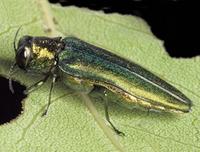-
CDC: outbreaks linked to imported foods increasing
U.S. food imports grew from $41 billion in 1998 to $78 billion in 2007; as much as 85 percent of the seafood eaten in the United States is imported, and depending on the time of the year, up to 60 percent of fresh produce is imported; the increase in imported food has been accompanied by an increase in foodborne illnesses, with fish and spices the most common sources
-
-
New wheat strain could ease food shortages
Researchers in Australia have developed a new strain of salt-tolerant wheat that could help minimize food shortages
-
-
U.S. faces new wave of invasive species

New study warns that the earlier onset of spring, warmer winters, economic globalization, and increased trade with emerging economies in Asia and Africa will see the United States face a significant new wave of invasive plant introductions; at least forty-two emerging U.S. trade partners – among them Thailand, Egypt, Saudi Arabia, Ecuador, Argentina, and several in equatorial Africa — are poised to export new nursery plant varieties to the United States
-
-
Focus on terrorism allowed foreign pests to slip into U.S.

Following the 9/11 attacks the U.S. government assigned hundreds of agricultural scientists responsible for stopping invasive species at the border to anti-terrorism duties; the result has been that dozens of foreign insects and plant diseases managed to slip undetected into the United States
-
-
FDA unveils new outbreak response network

Last week, the U.S. Food and Drug Administration unveiled its new streamlined approach for responding to foodborne illness outbreaks; under the “CORE” Network, the FDA Coordinated Outbreak Response and Evaluation Network, the FDA will bring together multidisciplinary teams consisting of epidemiologists, veterinarians, microbiologists, environmental health specialists, emergency coordinators, and risk communications specialists
-
-
China pushes for food security at G20 agriculture meeting
At a G20 meeting of agricultural ministers, Chinese officials urged their counterparts to address food security; China said addressing market volatility and food security is a top priority and that leaders should come to an agreement on how to handle soaring food prices; in recent years natural disasters, increases in demand, international speculation, and the increased use of biofuels have all caused food prices to spike
-
-
Risk of agroterrorism growing
The United States imports so much of its food and food ingredients from other countries, that terrorists have many more opportunities to harm Americans and damage the U.S. economy; a high FDA official said that increased U.S. attention to the issue and questions over whether hostile actors have the technical capacity to mount such an attack notwithstanding, the likelihood of being poisoned by intentionally contaminated food is growing
-
-
FDA looks for ways to fund $1.4 billion Food Safety Reform Act
Food-borne illness strikes 40 million Americans, hospitalizing 100,000, and killing thousands each year; on 4 January President Obama signed the long-awaited FDA Food Safety and Modernization Act into law — sweeping legislation that overhauls U.S. food-safety laws for the first time in more than seventy years; the Congressional Budget Office (CBO) estimated the food-safety law would cost about $1.4 billion in its first five years, including the cost of hiring an estimated 2,000 additional food inspectors; the passage of the legislation now presents FDA with the question of how to procure the funding required to implement and enforce the new system
-
-
New U.S. food safety law goes into effect
On 15 December the U.S. Centers for Disease Control and Prevention (CDC) issued its first estimate since 1999 of the toll of food-borne diseases in the United States: 48 million people sick each year, 128,000 hospitalized, and 3000 deaths; in the biggest overhaul of food safety in the United States since the 1930s, President Barack Obama yesterday signed a law giving the Food and Drug Administration (FDA) more power to inspect and shut down food producers yesterday, President Obama; critics say the law does not go far enough
-
-
New method to protect foods from anthrax contamination
An antibacterial enzyme found in human tears and other body fluids could be applied to certain foods for protection against intentional contamination with anthrax
-
-
FDA should adopt risk-based approach to food safety: report
Experts say that for food inspection in the United States to be more effective, FDA should implement a risk-based approach in which data and expertise are marshaled to pinpoint where along the production, distribution, and handling chains there is the greatest potential for contamination and other problems
-
-
Safer food imports goal of public-private venture
With imports accounting for 15 percent of the U.S. food supply, the United States needs a better way of ensuring food safety than border inspections; the University of Maryland teams up with a Massachusetts company to launch training center for foreign foodproducers
-
-
Texas A&M scientist tracks origins of bootleg honey from China
The United States has imposed a 500 percent tariff on honey from China two years ago because the Chinese government is subsidizing Chinese honey makers so they can drive U.S. producers out of the market; the practice has almost ruined the market for domestic U.S. honey; China is trying to get around the anti-dumping measure by putting labels such as “Product of Thailand” or “Product of Indonesia” on Chinese honey; a Texas A&M honey specialist stands in their way by doing melissopalynology — the study of pollen in honey
-
-
New center monitors safety of U.S. food imports
A new center will target shipments of imported cargo, including food, for possible safety violations; The center is one of six commercial targeting centers in the United States under Customs and Border Protection.
-
-
Senate panel approves food safety bill
The Senate last week passed a new food safety bill which would impose user fees, allow mandatory recalls, set performance standards, and impose civil penalties; some business associations are uncomfortable
-
- All
- Regional
- Water
- Biometrics
- Borders/Immig
- Business
- Cybersecurity
- Detection
- Disasters
- Government
- Infrastructure
- International
- Public health
- Public Safety
- Communication interoperabillity
- Emergency services
- Emergency medical services
- Fire
- First response
- IEDs
- Law Enforcement
- Law Enforcement Technology
- Military technology
- Nonlethal weapons
- Nuclear weapons
- Personal protection equipment
- Police
- Notification /alert systems
- Situational awareness
- Weapons systems
- Sci-Tech
- Sector Reports
- Surveillance
- Transportation
Advertising & Marketing: advertise@newswirepubs.com
Editorial: editor@newswirepubs.com
General: info@newswirepubs.com
2010-2011 © News Wire Publications, LLC News Wire Publications, LLC
220 Old Country Road | Suite 200 | Mineola | New York | 11501
Permissions and Policies
Editorial: editor@newswirepubs.com
General: info@newswirepubs.com
2010-2011 © News Wire Publications, LLC News Wire Publications, LLC
220 Old Country Road | Suite 200 | Mineola | New York | 11501
Permissions and Policies
